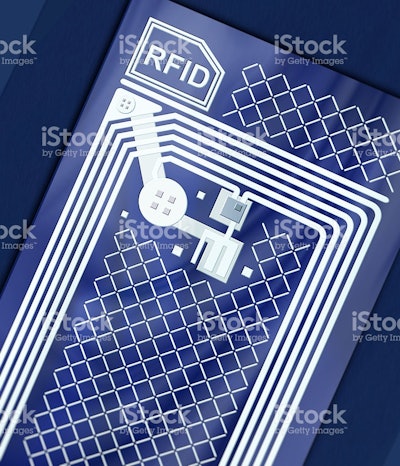
Food safety regulations, tracking and tracing, and improved visibility and performance in logistics are all important to the food supply chain. At the same time, costs for radio frequency identification (RFID) devices and barcode technology are dropping. Together, these factors are coalescing to generate an increase in RFID and barcode technology adoption in food and beverage (F&B) companies.
Technology Benefits F&B Industry
RFID started in the retail industry around 2001, but the F&B industry—a historically slow adopter—started moving into these technologies much later.
“At small food companies, we still see a lot of manual processes that are used to track food and execute logistics,” says Elizabeth Sinclair, manager of verticals marketing at Seagull Scientific, a barcode and labeling provider. “Unfortunately, today’s food supply chains are no longer a linear progression of events and are far too complex to track manually.
“For instance, you might receive a shipment of fish at your processing plant that is commingled from many different sources or you might send out a single product shipment to a multitude of destinations,” she continues. “The only way that companies can effectively track these multi-sourced and multi-delivered shipments is through technology that can integrate with master supply chain systems. RFID and barcoded technology has this integration ability.”
With RFID and barcoding, F&B companies now can track and record movements of goods, see their present locations, and even check their temperatures and humidities while they are en route. The ability to monitor food shipments in real time reduces risk of spoilage or waste. It also improves inventory and logistics management.
“If you’re shipping chicken in Florida and the temperature in the truck exceeds 42 degrees Fahrenheit for more than 15 minutes, you can see this situation immediately and take action,” explains Sinclair, “Or, if you get a red alert from a truck carrying perishable product because the truck’s environmentals failed, you can throw away that truckload if you have to—but at least you avoid the potential of a huge product recall.”
A massive product recall can sink a company. Sinclair recalls a Deloitte research study that found 80 percent of small companies fail when a massive recall is needed. “A recall can diminish your brand and cause irreparable damage to your reputation,” Sinclair says.
Barriers to Adoption
So, if improved tracking and tracing of goods, inventory management, quality control and recall avoidance are enabled with RFID and barcode technologies, why isn’t the F&B industry adopting them more aggressively?
“A major challenge is keeping up with everything, which leaves less time for anything else,” says David Kane, label design product manager for Teklynx, which produces barcode label software. “In its current process, a company might use one label and then discover that it needs other types of labels.”
Creating extra labels often is done on the spot and out on the floor. It can be a highly manual process that is fraught with error. Kane says that companies can help streamline the process by providing a library of labeling templates that retain standard label information that meets regulatory standards, while also enabling production workers to adjust the non-regulatory portions of labels. The technique saves time because employees don’t have to create new labels from scratch, with the possibility that errors might be introduced. An additional benefit for F&B companies, especially if they lack their own regulatory staffs, is that the labeling company tracks government labeling regulations and stays current with them.
“Regulatory compliance and staying on top of it is a major issue,” acknowledges Ken Moir, vice president of marketing at NiceLabel, a provider of barcode label printing software solutions. “In Europe, EU 1169 (www.gs1.org/eu-1169) was put in place two years ago and requires that you print allergen information on packaging. The next requirement that food companies must add is nutritional information.”
Moir points out the importance of using a standardized labeling method that can easily adjust to changes in government regulations or requirements from customers.
“There is a bakery in Belgium that has multiple stores and it found that many customers didn’t want to stand in line to wait for a sandwich,” says Moir. “So rather than lose these customers, the bakery decided to pre-make sandwiches, which it labeled with allergen and use-by dates. By doing this, the bakery was able to stay compliant in its food labeling. It also added another 3 to 4 percent to revenues because it could now capture business from customers who were walking away when the lines were too long. This resulted in an overall revenue gain of close to $20 million annually—but the process couldn’t have been executed without up-to-date labeling.”
Companies also experience labeling challenges when they are running multiple facilities, with each facility using different printers for labeling. “This becomes an integration challenge because the label printing software for each printer does not usually work with other printers,” Moir says. It is one reason why companies, like NiceLabel, developed universal label printer drivers that can work with all label and marking printers.
“If we can solve these issues for F&B companies, and also present a value proposition that makes these technologies easy to integrate, we can speed adoption and improve accuracy,” says Moir, who adds that companies often overlook the cost of human error.
“Companies need to be more cognizant of the cost of error because, when erroneous labeling data is introduced into the system, you don’t have integration with your central manufacturing execution and supply chain systems,” says Moir. “For example, if someone manually enters the wrong use-by date on a perishable food, an entire shipment may need to be scrapped, and the company loses that revenue or even the customer.”
Moir says that smaller F&B companies are vulnerable to these types of errors because many of them still enter their labeling and tracking data manually.
“In one case, we saw a group of smaller businesses that were acquired by a larger company, which found that each of these businesses were doing things their own way,” says Moir. “Major effort was needed to standardize both practices and systems. These small companies had different kinds of label and marking printers, so a major job was to create drivers for all of these printers that would enable them to all be easily integrated into a single manufacturing execution system.”
As they work to reduce the incidence of human error, F&B companies also need to look at optimizing business processes that enable faster times to market.
“A good example is the produce industry, where we have seen an increase in the use of returnable transfer unit containers and totes,” says Tom O’Boyle, director of RFID at Barcoding Inc., which deploys barcoding and RFID solutions. “Totes are reused, so the process of filling them, checking them in and emptying them, then cleaning them in preparation for reuse, can all be recorded into a central system with RFID. This process, when done manually, can take many hours to complete. With RFID, each step can be reduced to minutes and the introduction of human error is also significantly reduced.”
Back to the Future
Companies in the F&B sector are moving forward with RFID and barcode technologies. “RFID technology adoption is projected to grow year over year by 19.4 percent between now and 2020,” says Sinclair. “And barcode technology adoption is projected to grow annually at a rate of 11 percent through 2020.”
Over time, the expectation is that more companies will gravitate toward a hybrid adoption of both RFID and barcoding. For instance, for a pallet of beef, you could have data on where the cow lived, what it ate, etc., and all of this data could be stored in a barcode. Then, by using RFID, you could scan the data directly into your central system.
Another innovation that O’Boyle foresees is “sensor-based alerts that tell you when temperatures in containers are not in the proper ranges. The data tags on food will become more like data loggers that can provide information about the contents of your shipments every step of the way.”


















